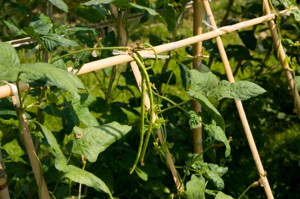
There is a growing movement among gardeners to be more water wise about what they plant. Here are some common edibles considered drought tolerant, and some tips that will help you conserve water when the weather turns dry.
Typically, edibles need somewhere in the range of 1-2 inches of water per week during the growing season, although this can vary according to their stage of growth. This amount of water is usually enough to soak the top 8-12 inches of soil.
Drought tolerant plants are not the same as drought resistant plants (true desert plants). Instead, they have been adapted (either through natural selection or engineered breeding) to survive for short periods of time with less water in arid climates. In most cases, the term drought tolerant applies to mature plants, not developing seedlings.
Like people, some fruits and vegetables are genetically designed to take the heat better than others. As a general rule, warm season crops (tomatoes, squash, melons) will usually fare better during a drought than cool season crops because they originate from parts of the world where periods of drought are part of the normal weather pattern. Many of these crops send their roots deep early, so by mid-summerís heat they are able to draw water from deeper in the soil.
Not every plant has the same needs at the same time. Most are tolerant to short periods of drought as long as they get water during crucial times. Instead of following a weekly watering schedule, focus on watering each plant according to its stage of development.

About The Author: Ellen Brown is an environmental writer and photographer and the owner of Sustainable Media, an environmental media company that specializes in helping businesses and organizations promote eco-friendly products and services. Contact her on the web at http://www.sustainable-media.com
Add your voice! Click below to comment. ThriftyFun is powered by your wisdom!
The best thing, not just vegetable, but your ornamentals, bushes, trees, etc, to conserve water, is to use mostly or exclusively the plants that are native to your area. They may not be as attractive as others, but they will do best in the long run.
Great article. I've wondered this myself with all this watering we do. Sure does make sense to pick more drought tolerant plantings. Here's an interesting thread on vegetable gardens.
www.oldhouseweb.com/
Add your voice! Click below to comment. ThriftyFun is powered by your wisdom!